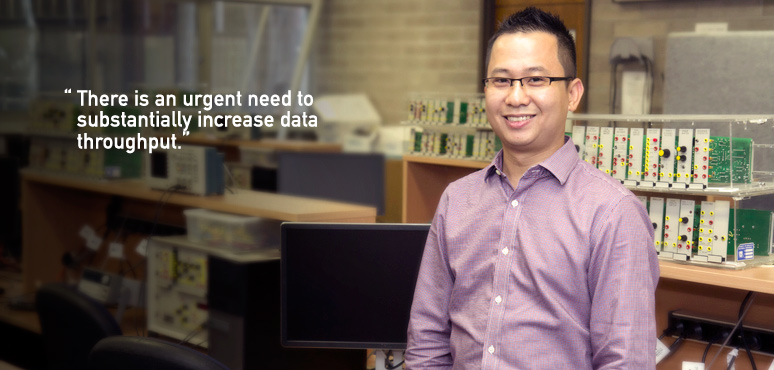Researcher Highlights
From tin cans to Telstra towers
Dr Duy Ngo
Adding to an international, fundamental knowledge base of wireless communications, Dr Duy Ngo is seeking to help commercial sectors capitalise on opportunities for 5G and beyond.

Dr Duy Ngo is tackling some of the most pertinent research questions within broadband wireless communications. This area requires multiple skill sets, including knowledge of complex international standards, practical features of real world systems and mathematical agility to solve extremely intricate, large scale optimisation problems. He's asking how and why, and what if, using mathematics to efficiently allocate the limited radio resources and maximise network performances. The winner of the 2015 Vice-Chancellor's Award for Research and Innovation Excellence for the Faculty of Engineering and Built Environment, is similarly employing optimisation theory to effectively manage signal interferences.
"There is an urgent need to substantially increase data throughput," he elaborates.
"We generate too much data currently so the communication network is overloaded."
"Every year the amount of data is doubled – how do we cope with that?"
"In 2020 it's projected this will jump by 1000 times."
Working to provide "faster, smarter and longer-lasting" wireless solutions, Duy acknowledges these problems are also chances for industry renewal and growth.
"It's about creating ideal trade-offs," he contends.
"Boosts in signal transmit power don't automatically mean boosts in data quantity."
Innovate and evaluate
Duy came to Australia in 2003, when he undertook a Bachelor of Engineering degree at the University of New South Wales. Four years later, the University medallist relocated to Canada, commencing a Master of Science degree at the University of Alberta.
"I followed up these academic efforts with a PhD at McGill University, where I was involved in a collaborative research and development project with Blackberry," he recalls.
"During this multi-year probe, I mathematically modelled the communication network and used optimisation theory to solve key issues related to interference management."
"Computers allowed me to generate large-scale numerical examples to verify my findings."
"In the end, I came up with several novel algorithms that were later published in the top journals of the Institute of Electrical and Electronics Engineers (IEEE)."
Down to the wire
Duy joined the University of Newcastle immediately after receiving his doctorate in 2013, signing on to become a lecturer within its School of Electrical Engineering and Computer Science. He's since spearheaded a number of research projects, most recently investigating the pros and cons of small-cell 5G networks.
"They've been suggested as one way of meeting widespread demand for pervasive wireless access," the expert explains.
"Basically, we would bring cell phones closer to the base station or access point."
"If we deploy a lot of them, however, signal interferences will be strong and unpredictable."
Of "significant" value, Duy's work in this area is set to benefit all leading telecommunication corporations, including Huawei and Qualcomm.
"I've successfully resolved several long-standing, non-convex combinatorial problems for power control and channel assignment," he affirms.
"For the first time, I've devised globally optimal radio resource management algorithms too."
"These are of extremely low complexity and offer very high throughput for large-scale networks."
A proven master at multitasking, Duy is also exploring the ins and outs of wireless energy harvesting. Contributing to the realisation of the 'Internet of Things,' he's proposing new power allocation and energy beamforming methods that maximise the amount of data transmitted to mobile devices whilst wirelessly and optimally charging those devices.
"We want to connect everything together, not just computers," the early career researcher asserts.
"This simultaneous wireless information and power transfer will assist many different fields."
"Heart-monitoring implants, biochip transponders and built-in car sensors would no longer need their batteries replaced, for example."
An active collaborator, Duy is in the process of identifying ways to "cut the last wire" as well.
"We're exploring options to make the wireless-powered network a reality," he states.
"It's very exciting."
In the loop
Similarly invested in vehicular networks, Duy has newly developed "advanced road safety communication solutions" too.
"I've created multi-hop transmission protocols that autonomously broadcast messages to all moving cars, trucks and buses with very low end-to-end delay and a very high success rate," he shares.
"These will be particularly useful and important when Google and Tesla rollout their self-driving vehicles in the future."
With "ups and downs" in this arena experienced over the last decade, Duy is promising to ensure Australia "keeps up" with what is happening abroad.
"I am a Chief Investigator in an Australian Research Council Linkage Grant with Ericsson AB in Sweden, the world's leading LTE network vendor," he advises.
"I'll be designing feedback control and optimisation algorithms for 5G."
"Work will begin in early 2016."
Related links
The University of Newcastle acknowledges the traditional custodians of the lands within our footprint areas: Awabakal, Darkinjung, Biripai, Worimi, Wonnarua, and Eora Nations. We also pay respect to the wisdom of our Elders past and present.